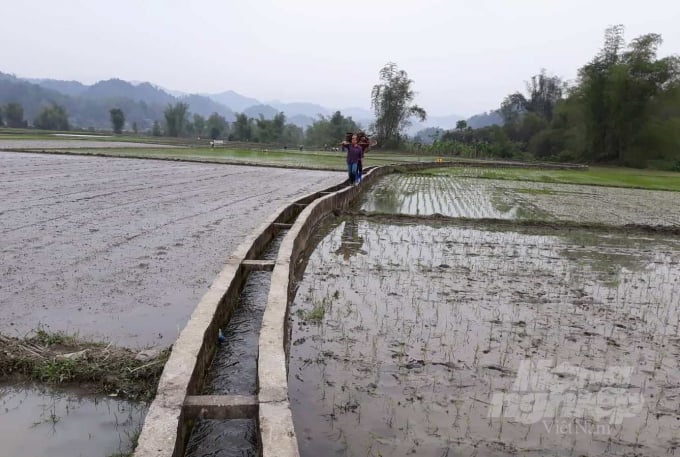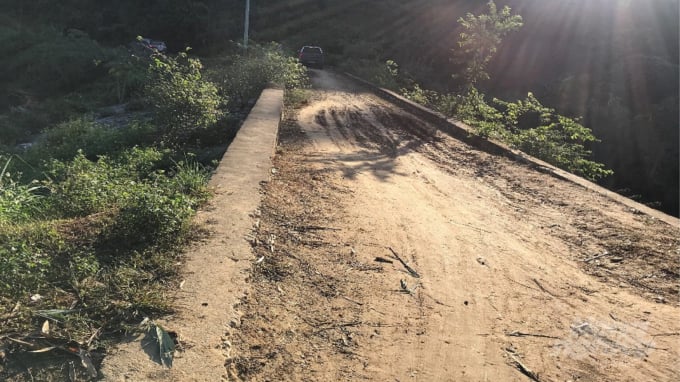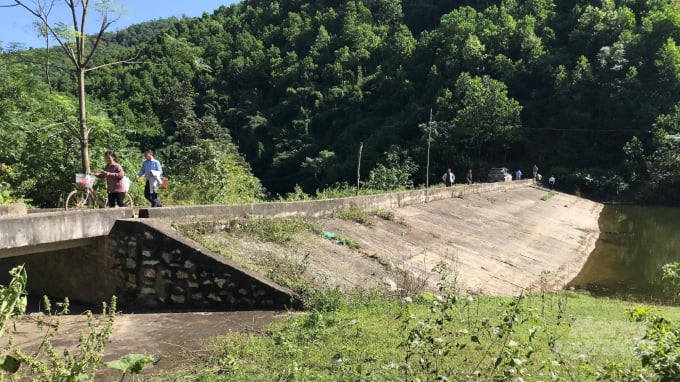May 21, 2025 | 03:31 GMT +7
May 21, 2025 | 03:31 GMT +7
Hotline: 0913.378.918
May 21, 2025 | 03:31 GMT +7
Hotline: 0913.378.918

Only about 20,000 hectares of Bac Kan's agricultural land, or less than 50%, are watered by irrigation systems. Photo: Toan Nguyen.
Bac Kan is a mountainous province, with more than 80% of the people living by agricultural and forestry production with a total area of nearly 486,000 hectares. The land for agricultural production is more than 44,000 hectares (accounting for only about 9%). But the area of land supplied water from irrigation works is less than 50%. As a result, the people mainly depend on rainwater or other industrial crops instead of rice.
The places where there is a shortage of water for irrigation in Bac Kan province are Sy Binh, Vu Muon, Cao Son communes of Bach Thong district; Hiep Luc, Thuong Quan, Duc Van, Bang Van, Coc Dan of Ngan Son district; and some other communes of Ba Be, Pac Nam, and Na Ri districts.
There are many reasons for the failure to invest in irrigation works in the localities mentioned above. But the most critical problem is that the budget of Bac Kan province is minimal. It has to rely on the investment resources of the Central and donor organizations.
Bac Kan is a poor province. Infrastructure is still lacking, and rural infrastructure has not been invested. In particular, the irrigation system for production is mainly small water reservoirs, which do not meet the requirements of agricultural production. As a result, farmers face many difficulties in agricultural production due to their dependence on natural rainwater.
With the amount of up to trillions of dong from the Government's capital sources, from Programs 135, 30a, 3PAD, or loan from ADB bank... Bac Kan province has planned and built irrigation works for water serving to agricultural production.

Na Don lake dam, Thanh Van commune, Cho Moi district has subsided. Photo: Toan Nguyen.
Over 20 years of construction and development, Bac Kan province has invested in building a number of irrigation works with capacity reaching several hundred hectares or more such as Deo But lake, Thom Trao lake (Cho Moi), Ban Chang lake (Ngan Son), Vang Giang dam, a cluster of Southeast irrigation projects, Nam Cuong irrigation works (Cho Don), Cam Bang irrigation works, Khuoi Khe lake (Na Ri), Nam Cut Lake (Bac Kan City)… In addition, there are thousands of other canal works.
Mr. Nguyen Trong Uyen, Deputy Director of Bac Kan Department of Agriculture and Rural Development, said that at present, irrigation reservoirs in the province are still operating, basically meeting the water supply for crops.
However, the works were built in the 80s of the last century, so there are signs of deterioration over time. Especially in recent years, due to climate change and unpredictable weather, irrigation works are at high risk of dam safety, threatening to cause damage to people's lives and properties. In addition to 5 works being repaired, several irrigation reservoirs are deteriorating and have not yet had the funds to repair.
Na Don lake in Thanh Van commune, Cho Moi district, Bac Kan province was built in 1986. After nearly 40 years of construction, exploitation, and use, up to now, the main dam route has revealed severe damage and deterioration.
Also, in Thanh Van commune, another irrigation lake, Tan Minh lake, is irrigating an area of nearly 46 hectares of agricultural land. The current construction is also degraded, such as the dam surface has many subsidence positions, the downstream roof does not have surface water drainage ditches.

Khuon Sao dam, Nhu Co Commune, Cho Moi District. Photo: Toan Nguyen.
Khuon Sao Irrigation Reservoir in Nhu Co Commune was built in 1990 and repaired once in 2015. The 3.5-meter wide dam has been reinforced but is now degraded. It is necessary to refinish the dam surface to ensure convenience for the operation and management. The downstream roof has no surface drainage ditches, no drainage rock piles to seep into the dam body.
According to Mr. Uyen, many irrigation works in Bac Kan urgently need to be repaired and upgraded. Still, the province faces difficulties, so they cannot allocate capital from the local budget. Therefore, the Department of Agriculture and Rural Development advises the Provincial People's Committee to propose funding from the Dam Rehabilitation and safety improvement project - WB8 (of the World Bank).
There are 34 irrigation reservoirs in Bac Kan province and about 2,400 dams, canal systems, and small pumping stations to serve irrigation for about 20,000 hectares of agricultural land. From mid-2020 until now, the Department of Agriculture and Rural Development of Bac Kan province has conducted a detailed inspection of each irrigation project.
Through inspection, the large and medium-sized irrigation reservoirs are operating well, without water seepage through the dam body, ensuring the amount of water for irrigation to serve agricultural production. However, an unsafe situation appeared among small irrigation works built over 30 years, even 60 years ago. There are 9 damaged works, 4 lakes have collapsed dam roof, upstream and downstream slopes; 3 lakes have dam body flooded, causing high unsafety.
Translated by Ha Phuc

(VAN) Japan's grant aid project contributes to capacity building, promoting organic agricultural production, and fostering sustainable community development in Dong Thap province.

(VAN) For years, the CRISPR-Cas9 genome technology has been reshaping genetic engineering, a precision tool to transform everything from agriculture to medicine.

(VAN) Vietnam aims to become a 'leader' in the region in the capacity and managing effectively soil health and crop nutrition.
![Reducing emissions from rice fields: [Part 1] Farming clean rice together](https://t.ex-cdn.com/nongnghiepmoitruong.vn/608w/files/news/2025/05/05/z6509661417740_a647202949c539012a959e841c03e1d3-nongnghiep-143611.jpg)
(VAN) Growing clean rice helps reduce environmental pollution while increasing income, allowing farmers to feel secure in production and remain committed to their fields for the long term.
/2025/05/19/5136-1-144800_230.jpg)
(VAN) The Nghe An Provincial People's Committee has just approved the list of beneficiaries eligible for revenue from the Emission Reductions Payment Agreement (ERPA) in the North Central region for the year 2025.

(VAN) 14 out of 35 domesticated elephants in Dak Lak province have had their living conditions improved, with 11 of them currently participating in the non-riding elephant tourism model.

(VAN) Muong Nhe Nature Reserve hopes that being upgraded to a national park will lay the foundation for forest protection efforts to be carried out in a systematic, modern, and sustainable manner.